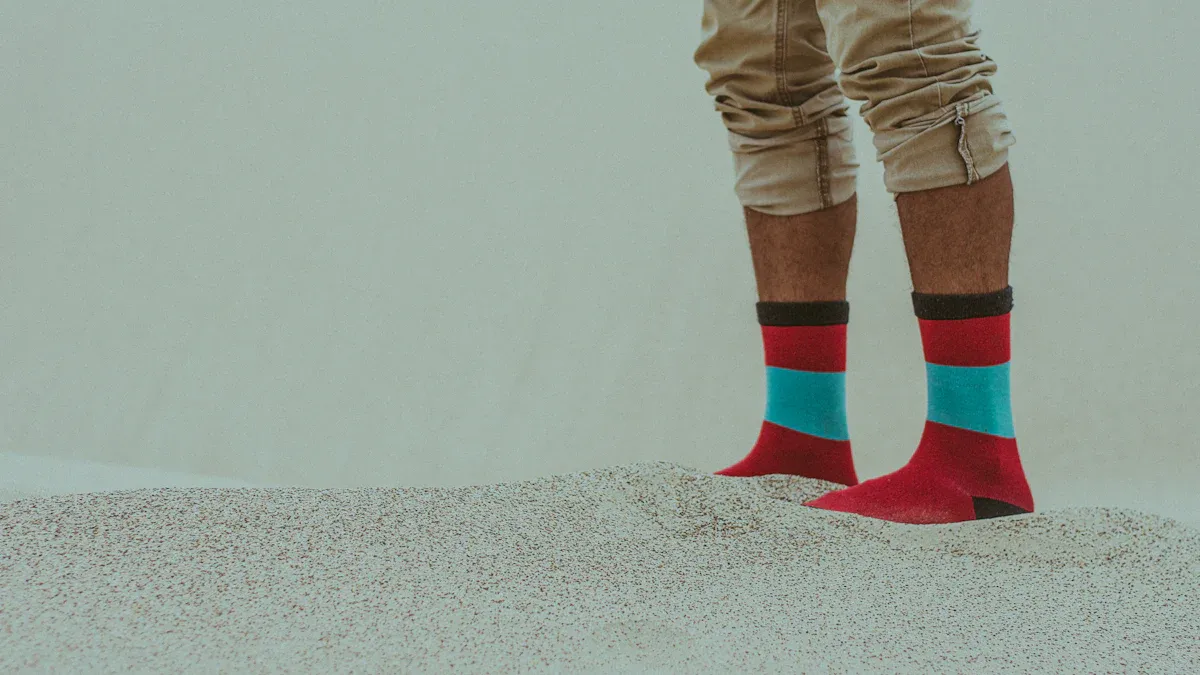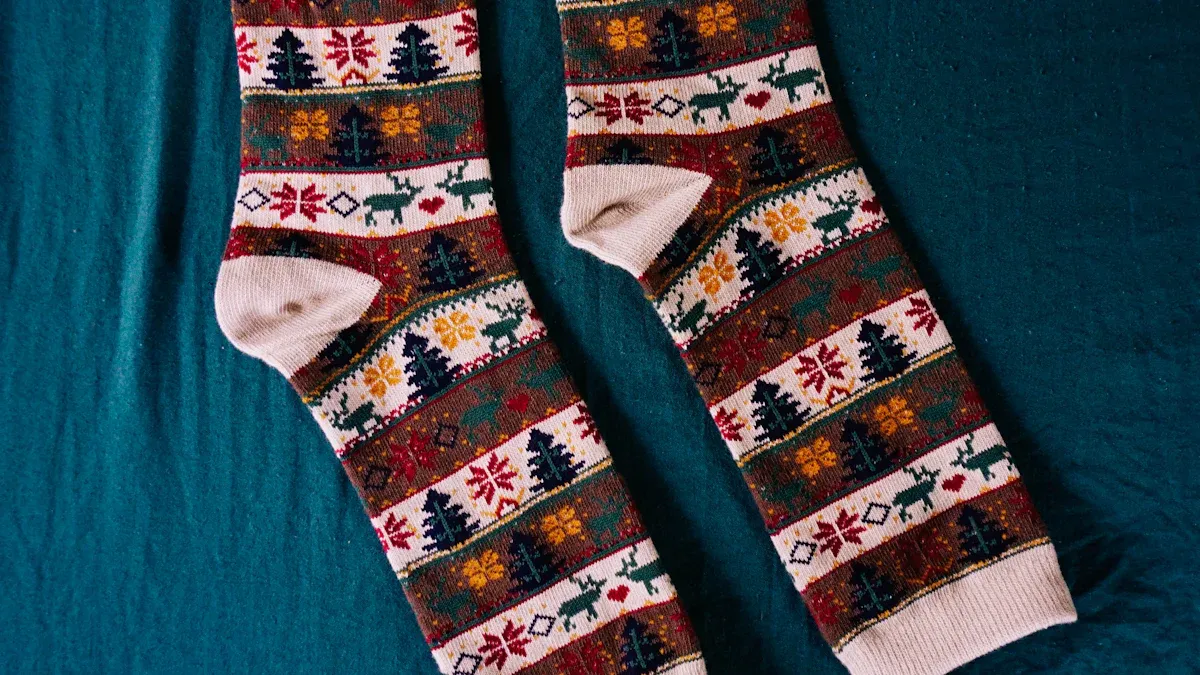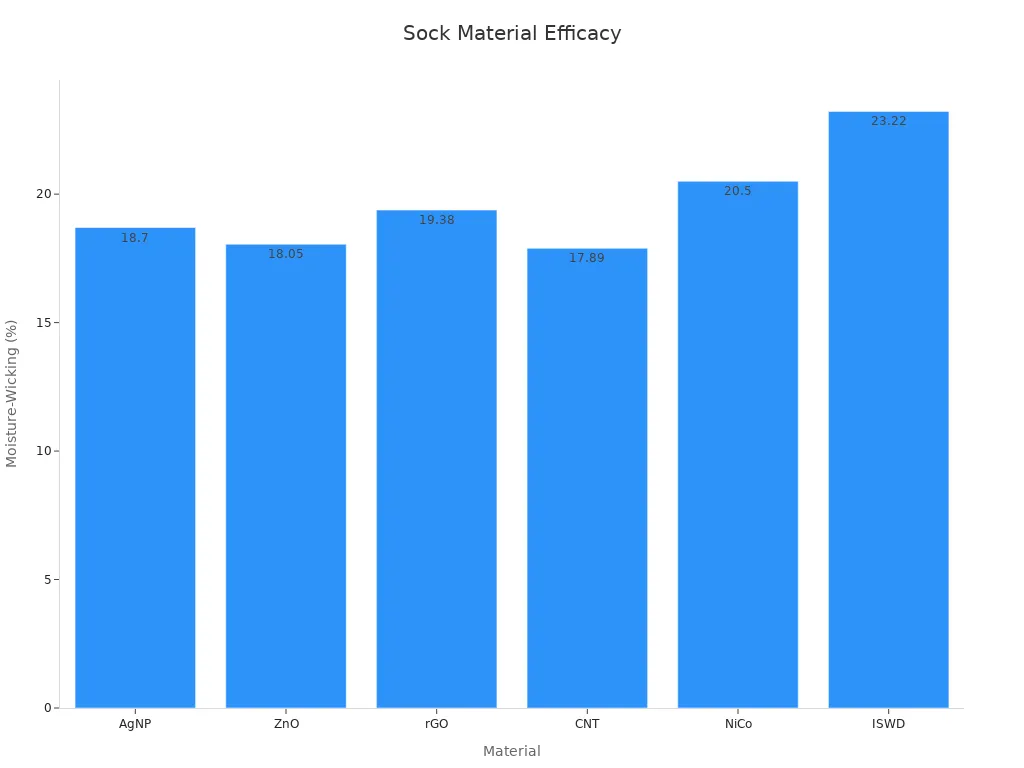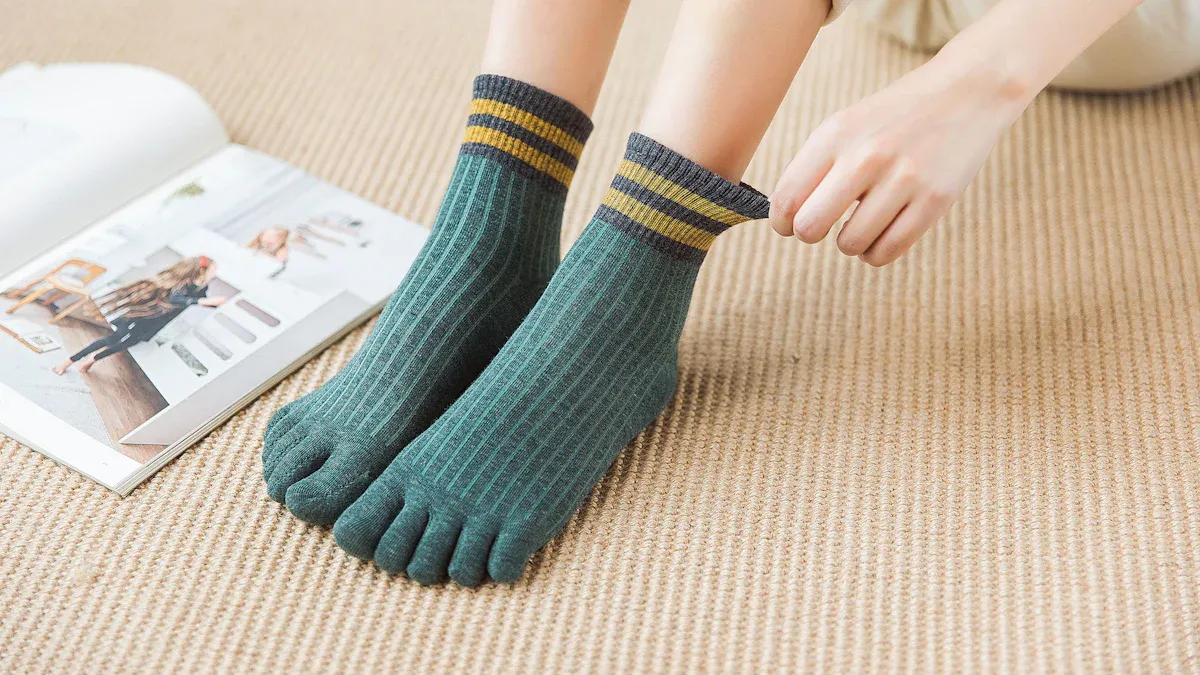
Finding the perfect pair of socks can make a big difference in your day. Whether you're heading to the gym, going for a hike, or just lounging at home, the right socks keep your feet comfortable and supported.
Did you know that 73% of athletes believe their performance improves with the right socks? It’s no surprise, considering the growing demand for quality options in the $7.4 billion athletic socks market.
So, choosing wisely isn’t just about style—it’s about comfort and performance too.
Key Takeaways
- Pick socks with materials that pull sweat away, like Merino wool or synthetic fabrics, to keep feet dry and comfy.
- Find socks with padding and no seams to feel better and avoid blisters while moving.
- Think about sock length and thickness for your activity to give your feet the best support and safety.
Which Material Works Best for Your Needs?

Cotton, Wool, and Blends
When it comes to socks, the material plays a huge role in how they feel and perform. Cotton is a popular choice because it’s soft and breathable, making it great for everyday wear. However, it doesn’t wick moisture well, which can leave your feet feeling damp during intense activities. Wool, especially Merino wool, is a game-changer. It’s not only warm but also naturally odor-resistant and moisture-wicking. A study from Deakin University found that 100% wool had the highest odor absorption compared to polyester and blends. Plus, Merino wool uses less energy during washing, making it an eco-friendly option.
Blended fabrics combine the best of both worlds. For example, a mix of wool and synthetic fibers can enhance durability while keeping your feet dry and comfortable. Here’s a quick comparison to help you decide:
| Material | Moisture-Wicking Ability | Durability | Breathability | Suitability for Activities |
|---|---|---|---|---|
| Cotton | Low | High | High | General use |
| Merino Wool | High | High | Moderate | Cold and warm climates |
| Regular Wool | Moderate | Moderate | Moderate | Cold climates |
| Synthetics | High | High | Low | Varied activities |
Moisture-Wicking and Breathability
If you’ve ever had sweaty feet, you know how uncomfortable it can be. That’s where moisture-wicking materials come in. These fabrics pull sweat away from your skin, keeping your feet dry and reducing the risk of blisters. Wool and synthetic blends are excellent at this. In fact, studies show that materials like NiCo and ISWD have moisture-wicking efficacy rates of over 20%. Check out this chart for a visual breakdown:

Breathability is just as important. It ensures proper airflow, preventing your feet from overheating. Wool and cotton excel in this area, making them ideal for both warm and cool climates. When choosing socks, look for materials that balance moisture-wicking and breathability for maximum comfort.
Why Are Comfort and Fit Important When Choosing Socks?

Cushioning and Support
When it comes to comfort, cushioning is a game-changer. The right amount of padding can make your socks feel like a soft cloud underfoot. Different types of cushioning serve different purposes. Standard cushioning, for example, adds soft loops under your feet, making it durable and cozy for everyday wear. Contoured cushioning takes it a step further by shaping itself to your foot, reducing the chance of blisters and easing fatigue. If you’re into specific activities like running or hiking, targeted cushioning focuses on high-impact areas, giving you the support you need where it matters most.
Athletic footwear often fails to protect against repetitive impact injuries, despite claims of advanced cushioning technologies. Studies even suggest that running barefoot can reduce injury risks and lower energy costs by about 4%.
So, whether you're walking, running, or just relaxing, choosing socks with the right cushioning can make a noticeable difference in how your feet feel throughout the day.
Seamless Designs and Elasticity
Have you ever felt an annoying seam digging into your toes? Seamless socks solve this problem by eliminating friction and pressure points. This design reduces the risk of blisters and keeps your feet comfortable, especially during long activities. Elasticity is another key factor. A good elastic band keeps your socks in place without cutting off circulation. Non-restrictive elastic designs also promote better blood flow, which helps prevent fatigue during physical activities.
When shopping for socks, look for seamless designs and just the right amount of stretch. These features ensure a snug fit without compromising comfort, making them perfect for all-day wear.
How Does Your Activity Determine the Type of Socks You Need?

Athletic and Sports Socks
When you're active, your feet work just as hard as the rest of your body. That’s why choosing the right socks for athletic activities is so important. Specialized sports socks are designed to keep up with your movements while offering maximum comfort and protection. They often feature moisture-wicking materials to keep your feet dry, which helps prevent blisters during intense workouts. Superior cushioning provides extra support, reducing foot fatigue and lowering the risk of injuries. Compression fits are another game-changer, as they improve blood circulation and help your muscles recover faster.
Here’s a quick breakdown of how these features impact your performance:
| Feature | Benefit | Impact on Performance Metrics |
|---|---|---|
| Moisture-wicking | Keeps feet dry, preventing blisters and discomfort | Enhances comfort during intense workouts |
| Superior cushioning | Provides support and protection, reducing foot fatigue and injuries | Improves overall comfort and reduces injury risk |
| Compression fit | Promotes better blood circulation, reducing muscle fatigue | Enhances athletic performance and speeds recovery |
Investing in high-quality sports socks can make a noticeable difference. They’re not just about comfort—they’re about helping you perform at your best.
Everyday and Outdoor Socks
For daily wear or outdoor adventures, your socks need to handle a variety of conditions. Everyday socks should prioritize comfort and durability, while outdoor socks must offer additional features like temperature regulation and moisture management. Merino wool is a fantastic choice for outdoor activities. It wicks away sweat, keeps your feet warm in winter, and cools them in summer. Blended materials are also great for combining softness with durability.
Here’s why choosing the right socks matters for these activities:
| Benefit | Description |
|---|---|
| Reduced Foot Fatigue | Proper cushioning and support help prevent foot fatigue, especially during prolonged activities. |
| Blister Prevention | Well-designed socks reduce friction and provide a barrier against blister-causing factors. |
| Temperature Regulation | Good socks help maintain an optimal temperature, keeping feet warm in winter and cool in summer. |
| Moisture Management | Effective moisture-wicking properties keep feet dry, reducing the risk of fungal infections. |
Whether you’re running errands or hiking a trail, the right socks can keep your feet comfortable and protected all day long.
What Sock Style and Length Are Best for You?

Choosing the Right Sock Height
The height of your socks can make or break your comfort during different activities. Whether you're running, hiking, or just heading to work, the right sock height matters. For example, quarter-length socks are perfect for summer hikes with low-rise boots. They keep your feet cool while protecting your ankles from chafing. Micro Crew socks, on the other hand, are slightly taller and work well with hiking boots, offering extra coverage and reducing friction. Crew socks are the most versatile. You can wear them for casual outings, gym sessions, or even as part of your work attire.
Different activities also call for varying sock thickness. Runners often prefer thin, breathable socks for better moisture control. Hikers might go for thicker options to cushion their feet on rough terrain. If you're into winter sports, thick socks provide insulation and keep your feet warm. Choosing the right height and thickness ensures your socks match your needs, keeping you comfortable all day.
Patterns and Aesthetic Preferences
Socks aren't just functional—they're a fashion statement too. Today, many people use socks to express their personality. Bold patterns, vibrant colors, and even artistic designs are becoming increasingly popular. This trend reflects a shift toward self-expression in fashion. You might also notice a growing demand for sustainable materials and customizable designs. Eco-friendly socks not only look great but also align with the values of environmentally conscious shoppers.
Athleisure fashion has also influenced sock designs. Performance socks now combine functionality with style, making them suitable for workouts and casual wear. Whether you prefer minimalist designs or eye-catching patterns, there's a pair of socks out there that fits your style perfectly.
How Can You Ensure Your Socks Are Durable and Easy to Maintain?

Identifying Long-Lasting Socks
When it comes to durability, not all socks are created equal. Some pairs wear out after just a few uses, while others can last for months or even years. So, how do you spot socks that can go the distance? Start by looking at the materials. High-quality blends, like Merino wool combined with synthetic fibers, tend to resist wear and tear better than pure cotton. Reinforced heels and toes are also a good sign—they add extra strength to areas that experience the most friction.
Durability testing can also give you an idea of how socks perform under tough conditions. For example:
"I am a tractor mechanic, and spend 10-12 hours a day on my feet wearing steel toe boots. I would ruin normal boot socks after wearing them 10-15 times. I bought two pairs of these socks to start out. I have been wearing them 3 times a week for a month to see how they hold up. These socks are the most comfortable and durable I have ever worn. They feel the same as new, and show no signs of wear." — Jeremy H.
Manufacturers often test socks for durability using advanced methods. These include:
- Highly accelerated lifetime testing.
- Temperature and humidity testing.
- Mechanical impact assessments.
- Solar and UV exposure evaluations.
Here’s a quick look at durability testing across categories:
| Product Category | Testing Details |
|---|---|
| Durable Fashion | Socks and hosiery |
| Durable Textiles | Tested after 40 washes (SILVER) and 50 (GOLD) |
| Durable Footwear | Comprehensive testing across footwear types |
Proper Care and Replacement
Taking care of your socks can significantly extend their lifespan. Regular washing with lukewarm water and mild detergent keeps them clean and maintains their elasticity. Rotating between at least three pairs allows each pair to dry fully and recover its shape. Proper storage, like folding instead of balling them up, also helps prevent stretching.
To keep your socks in top condition, follow these tips:
- Wash with lukewarm water and mild detergent.
- Rotate between multiple pairs to avoid overuse.
- Check for wear after each use and store them neatly.
Eventually, even the best socks need replacing. Look for signs like holes, thinning fabric, or loose elastic. Worn-out socks can cause discomfort or even affect your performance. If you notice slipping or irritation, it’s time to invest in a new pair. For athletes, replacing socks more frequently might be necessary due to sweat and dirt buildup.
By choosing durable socks and caring for them properly, you can save money and keep your feet happy for longer. 🧦
Conclusion
Choosing the right socks can make a world of difference for your feet. By focusing on material, comfort, purpose, style, and durability, you ensure every step feels better. Did you know 73% of runners prioritize comfort, and 68% replace low-quality pairs due to wear? Prioritize quality, and you’ll enjoy both comfort and performance every day.
FAQ
What are the best socks for sweaty feet?
Look for socks made from moisture-wicking materials like Merino wool or synthetic blends. These fabrics keep your feet dry and reduce the risk of blisters. 🧦
How often should you replace your socks?
Replace socks when they show signs of wear, like holes, thinning fabric, or loose elastic. For athletes, replacing them every few months ensures optimal performance.
What’s the easiest way to care for your socks?
Wash socks in lukewarm water with mild detergent. Rotate between pairs to avoid overuse. Store them neatly to maintain their shape and elasticity.
Related:
1.20 TOP SOCKS STATISTICS IN 2025 →
2.Wool reduces body odour →
3.Comparing sock material →
4.Intelligent sportswear design →
5.Our Sock Cushions: A Complete-ish Guide →
